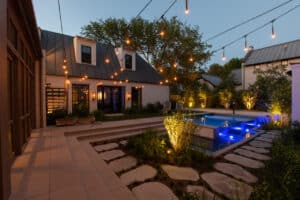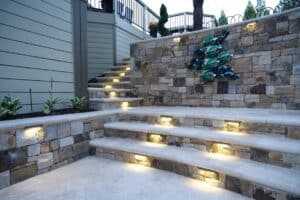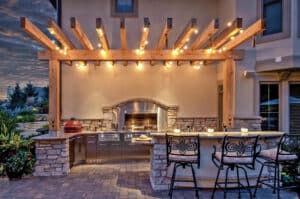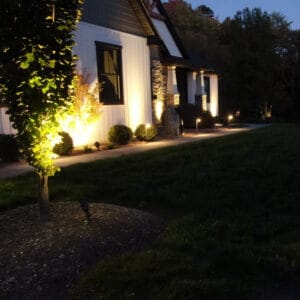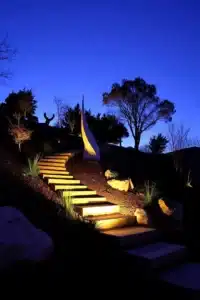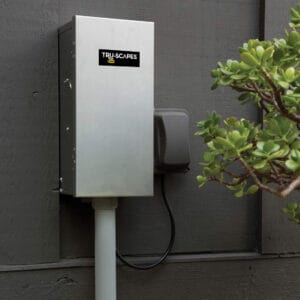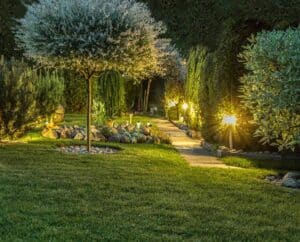Does the world of outdoor lighting sometimes feel a bit… much? Flicking through magazines or scrolling online can present a dizzying array of floodlights, competing spotlights, and runway-style paths that scream for attention. What if the secret to a truly high-end, captivating outdoor space wasn’t about adding more lights, but about being more intentional with less?
This is the power of minimalist landscape lighting. It’s a design philosophy that champions simplicity, subtlety, and sophistication. By the end of this article, you’ll understand the core principles of minimalism, which align with the principles of professional landscape design, and learn how to use professional-grade, low-voltage lighting to make your home the standout on the block—for all the right reasons.
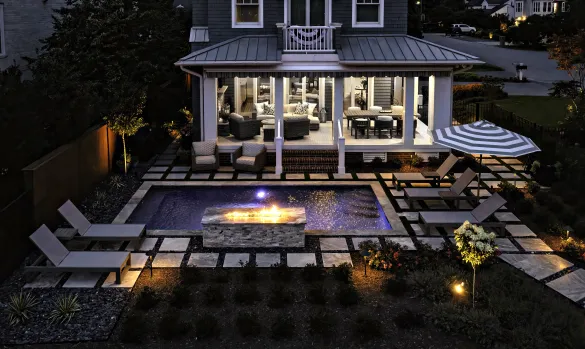
What Exactly Is Minimalist Landscape Lighting?
Minimalism in lighting isn’t about leaving your yard in the dark. It’s a disciplined approach focused on clean lines, architectural details, and purposeful illumination. Instead of flooding an area with light, you use a curated selection of high-quality fixtures to draw attention to specific features. Think of it as the difference between a shout and a whisper; both get attention, but one is far more intriguing.
This design style celebrates negative space—the shadows—as much as it does the light itself. The darkness provides contrast, creating depth and drama that makes the illuminated features pop. It’s about creating a mood and an experience, guiding the eye rather than overwhelming it.
The “Less Is More” Advantage: Why Go Minimalist?
Choosing a minimalist approach offers more than just a clean aesthetic. For middle-aged homeowners invested in their home’s decor and value, the practical benefits of low-voltage LED lights are significant.
| Feature | Minimalist Lighting Approach | Traditional/Over-Lit Approach |
| Curb Appeal | Creates a sophisticated, high-end look that enhances architectural details. | Can appear cluttered, dated, or overwhelming, hiding the home’s features. |
| Focus | Draws the eye to key features like a prized Japanese maple or a stone facade. | Lacks a clear focal point, leading to a flat and uninteresting view. |
| Ambiance | Fosters a warm, inviting, and serene atmosphere by following responsible outdoor lighting principles that reduce glare. | Often produces harsh glare and an atmosphere that feels more commercial than cozy. |
| Energy Use | Utilizes fewer, strategically placed fixtures that, according to research, can significantly lower energy consumption. | Requires more fixtures and often higher wattage, leading to higher electricity bills. |
Core Principles for Mastering Minimalist Designs
Achieving a beautiful minimalist look is an art, but it’s one built on simple, repeatable principles. By focusing on quality and placement, you can create a professional-level design.
1. Identify Your Focal Points
Before you even think about a fixture, walk around your property during the day. What are the standout features?
- Architectural Details: Learning how to use light for highlighting your home’s architectural details—like textured surfaces, columns, or unique rooflines—is a great place to start.
- Landscape Elements: A mature oak tree, a structured garden bed, a winding stone path, or a water feature.
- Functional Zones: Your patio, deck, entryway, or outdoor kitchen.
Choose a few key features to highlight. A minimalist design might only focus on the entryway, a large tree, and the path connecting them. This restraint is what creates a powerful impact.
2. Embrace the Shadows
In minimalist design, darkness is a tool. Don’t feel the need to light every corner of your yard. Shadows create visual interest and prevent the scene from looking flat. The space between two subtle path lights is just as important as the pools of light they create. This interplay between light and dark is where the magic happens, lending a sense of mystery and elegance to your landscape.
3. Choose Sleek, High-Quality Fixtures
Your light fixtures should complement the minimalist aesthetic, not detract from it. Look for fixtures with simple, clean lines and durable materials. Solid brass and professional-grade aluminum are excellent choices as they age beautifully and withstand the elements.
Tru-Scapes offers a range of fixtures perfect for modern designs:
- Well Lights: Installed flush with the ground, these are the ultimate minimalist tool for uplighting trees or walls without any visible hardware.
- Sleek Path Lights: Choose fixtures like the Modern Path Light (TS-B306) that have a simple profile and direct light downward, preventing glare.
- Hardscape Lights: You can explore our collection of integrated Hardscape Lights, which are tiny fixtures designed to be tucked directly into structures like stair treads, retaining wall caps, or bench seating to provide safety and ambiance without being seen.
4. Layering with Purpose
Professional lighting design isn’t about a single type of light. It’s about layering different kinds of light to create a cohesive scene.
- Task Lighting: This is for safety and function, like lighting steps and pathways.
- Accent Lighting: This is for highlighting your focal points, like using a spotlight on a sculpture or a well light on a tree.
- Ambient Lighting: This provides overall soft, general illumination for gathering areas like patios and decks.
In a minimalist design, these layers are subtle. A few hardscape lights on the steps (task), a single spotlight on a beautiful birch tree (accent), and a pair of gentle wall sconces on the patio (ambient) can be all you need.
5. Mind the Color Temperature
The warmth or coolness of the light, measured in Kelvins (K), dramatically affects the mood. Understanding how color temperature affects the mood is key. For a welcoming and natural look, stick to a warm white light, typically in the 2700K to 3000K range. This mimics the warm glow of interior lighting, creating a seamless transition from inside to out. Consistency is key in minimalist design, so using the same color temperature across all your fixtures will create a unified, harmonious look.
Lighting Inspiration: Minimalist Ideas for Your Home
So, how do these principles look in the real world? Here is some lighting inspiration to get you started.
For the Modern Facade
- Grazing Technique: If you have a home with beautiful texture (stone, brick, or board-and-batten siding), use the grazing technique. Place spotlights or well lights very close to the base of the wall and aim them straight up. This creates dramatic shadows across the surface, highlighting the texture in a subtle yet stunning way.
Guidance for lighting Walkways and Paths
- Staggered Placement: Avoid placing path lights in a straight line like an airport runway. Instead, stagger them on alternating sides of the path. This creates a more organic, meandering feel. Place them just far enough apart to create distinct pools of light that guide the way without overwhelming the journey.
Find more inspiration for Patios and Decks
- Integrated Hardscape Lights: The best minimalist deck and patio lighting is the light you can’t see. Install hardscape lights under stair risers, along the perimeter of the deck, or beneath the capstones of a seating wall. This provides essential safety lighting while casting a soft, downward glow that defines the space without any visible fixtures or glare.
For Trees and Gardens
- A Single, Dramatic Uplight: You don’t need to light every plant. Choose the most impressive tree in your yard—one with a unique shape or beautiful bark—and illuminate it with a single, well-placed spotlight or a pair of well lights. This single point of light will turn the tree into a living sculpture, creating a dramatic focal point that anchors your entire landscape design.
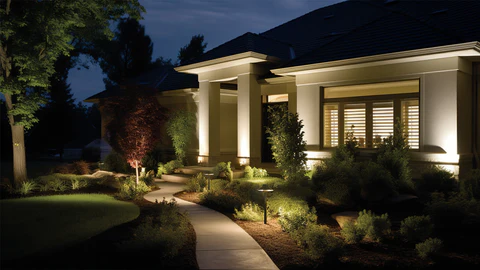
Final Thoughts: Quality and Simplicity Reign Supreme
Creating an elegant, modern outdoor space doesn’t require a dozen different types of lights. By embracing a minimalist philosophy, you can achieve a far more impactful and sophisticated result. Focus on highlighting your home’s best features, choose high-quality, low-voltage LED fixtures that blend into the environment, and don’t be afraid of the dark. The resulting ambiance will not only extend your living space into the outdoors but will also add timeless curb appeal and value to your home.
Ready to transform your property with the power of minimalist design? Start by exploring professional-grade fixtures that are built to last and designed for beauty.
What’s your favorite minimalist lighting look? Share your thoughts or questions in the comments below!

